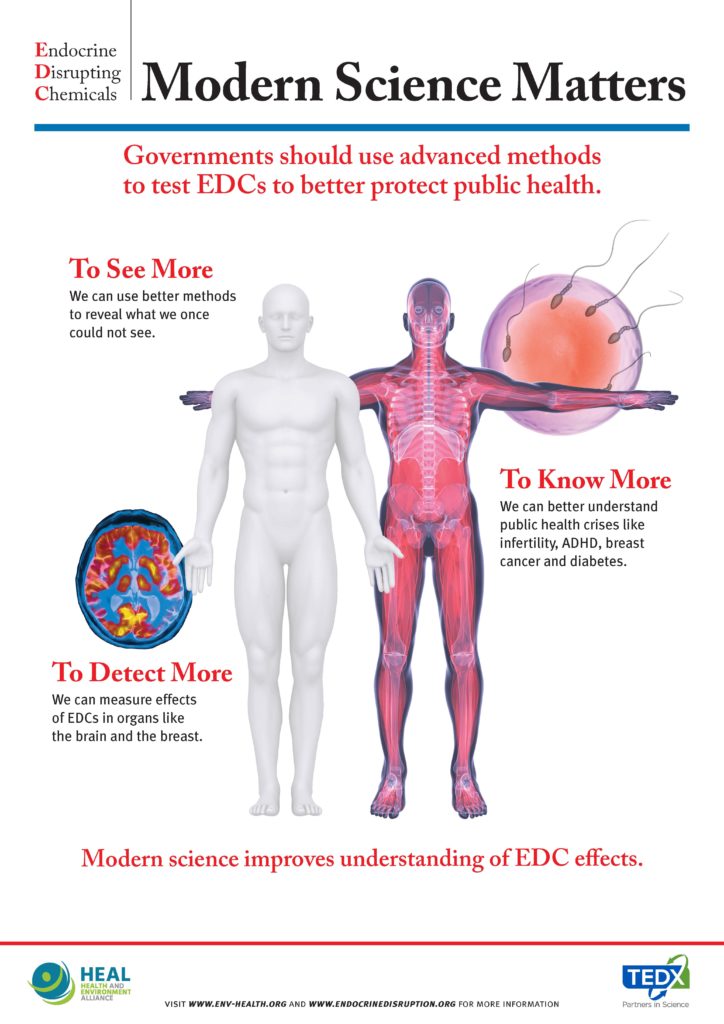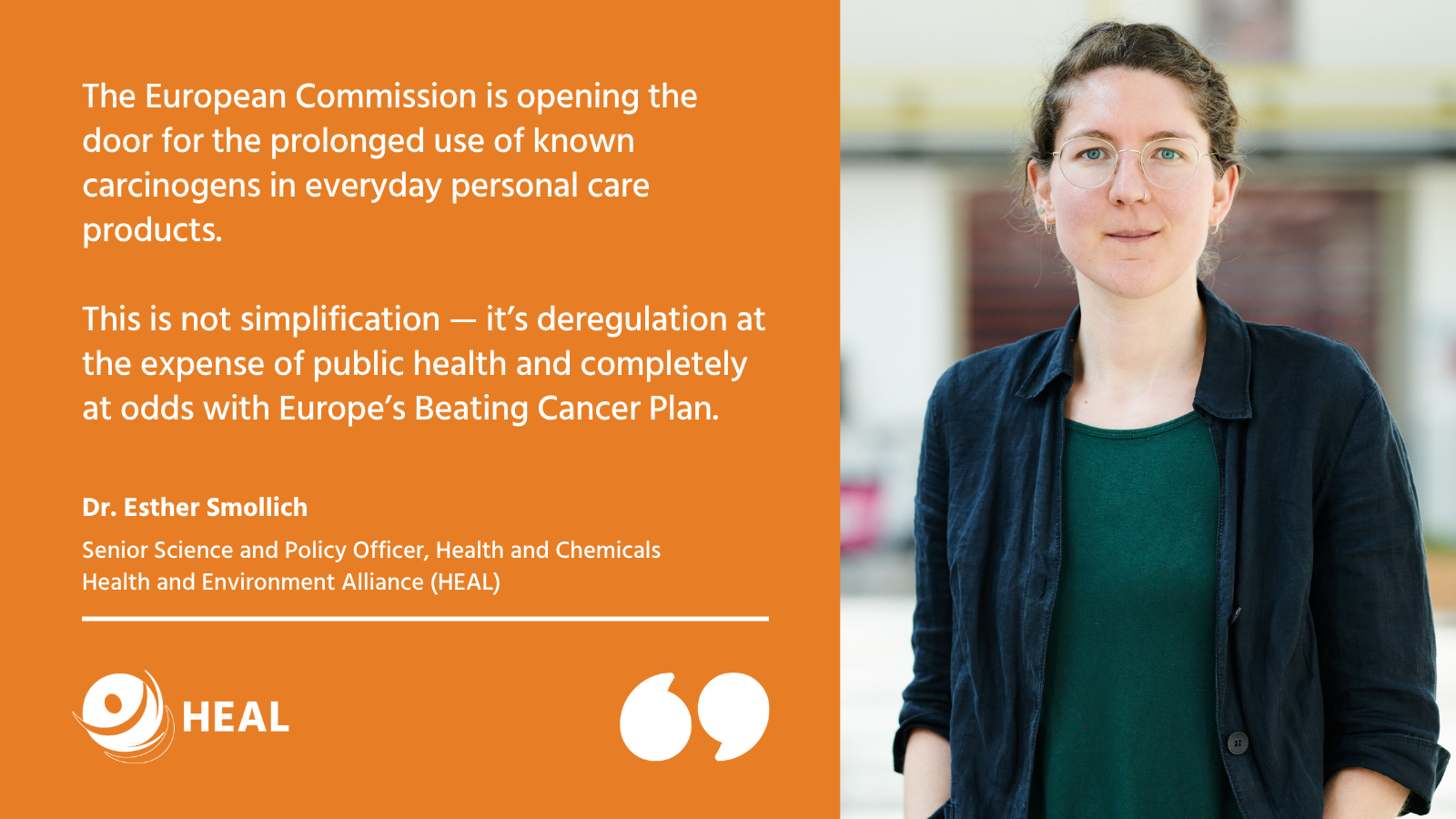Today’s publication of the European Commission’s chemicals omnibus confirms serious concerns: if pushed through the proposal will significantly weaken protections in the Cosmetic Products Regulation, allowing the prolonged use of carcinogens and other harmful chemicals in personal care products.
Findings from the European research project EDC-MixRisk released today [1] highlight that the health risks associated with the combined exposures to endocrine disrupting chemicals (EDCs) are systematically underestimated under current assessment methods in the European Union. Researchers behind the project now call for a shift in risk assessment to better reflect real-life exposure to multiple chemicals throughout life.
EDC-MixRisk is an EU Horizon 2020 research project that investigated how prenatal exposure to mixtures of 54 suspected EDCs affects the development and health of children. Using epidemiological data to create and test real-life mixtures of EDCs associated with adverse health effects, the project has developed new tools to enhance current risk assessment practices.
EDCs are ubiquitous and lifelong human exposure to this large class of chemicals has been linked to a series of serious health conditions [2] that bear a heavy cost on wellbeing and the economy [3]. However, the focus on single substances in current risk assessments and regulations has been recognised as an important shortcoming in Europe’s approach to endocrine disruptors and remains a challenge when it comes to crafting public policies that effectively prevent diseases [4].
Genon K. Jensen, Executive Director at the Health and Environment Alliance (HEAL) said: “Just when the European Commission is expected to roll out its action plan to overhaul Europe’s approach to endocrine disruptors, these findings call for an urgent reform of the methods used to assess and regulate these chemicals, to reflect real-life exposure and truly protect the health and future development of our children.”
Interesting findings:
- Chemicals identified in the project came from different sources and fall under different regulations;
- Exposure to mixtures of EDCs at the prenatal stage has been associated with adverse health and development effects of children in three domains: sexual development, neurodevelopment and metabolism and growth;
- Tested mixtures affected hormone-regulated and disease-relevant outcomes in various models at the same concentrations found in pregnant women;
- Using the assessment approach developed through the project indicated a higher risk for exposed children than when using methods focusing on single chemicals.
Policy implications:
- Researchers highlight that health risks associated with combined exposures to EDCs are systematically underestimated;
- The newly developed methods should already be used to better inform European risk assessments and the regulation of EDCs in the most health-protective way, when epidemiological data exists;
- In the absence of epidemiological data, these findings can inform current discussions and efforts to reform risk assessments in a way that takes into account mixtures and combined exposures in the future.

Infographic: Modern Science Matters (released March 2019). Available for download.
As these findings are being presented and discussed, the European Commission is soon expected to launch a fitness check of all EU regulations related to endocrine disruptors in the coming weeks. This fitness check will form the backbone of a planned revision of the European strategy on endocrine disruptors [5].
Contact: Natacha Cingotti, Senior Health and Chemicals Policy Officer at HEAL, natacha@env-health.org, tel.: +32 (0)2 234 36 45
Notes to the editors:
[1] For more info on EDC-MixRisk, see press release: https://edcmixrisk.ki.se/2019/03/26/press-release-health-risks-associated-with-mixtures-of-man-made-chemicals-are-underestimated/; and the policy brief: https://edcmixrisk.ki.se/wp-content/uploads/sites/34/2019/03/Policy-Brief-EDC-MixRisk-PRINTED-190322.pdf [2] European Parliament, Report for the Petitions Committee, “Endocrine Disruptors: from Scientific Evidence to Human Health Protection”, 20 March 2019, http://www.europarl.europa.eu/RegData/etudes/STUD/2019/608866/IPOL_STU(2019)608866_EN.pdf [3] Leonardo Trasande et al, “Burden of disease and costs of exposure to endocrine disrupting chemicals in the European Union: an updated analysis”, July 2016, https://www.ncbi.nlm.nih.gov/pmc/articles/PMC5244983/ [4] See for example:- European Commission, Communication on Endocrine Disruptors, 7 November 2018, http://ec.europa.eu/transparency/regdoc/rep/1/2018/EN/COM-2018-734-F1-EN-MAIN-PART-1.PDF
- Council of Environment Ministers, debate, 5 March 2019 https://video.consilium.europa.eu/en/webcast/5869bc6b-2240-4e0d-b9db-c0dbc5db9750
- EDC Free Europe, “Eight demands for a European EDC-Free strategy”, 15 May 2018 https://www.edc-free-europe.org/articles/position-papers/eight-demands-edc-strategy
“Reduce our EDC daily cocktail: Replace the substance-by-substance approach by including all possible sources of exposure to multiple chemicals
• Prioritise the identification and regulation of the most problematic groups of hormone disrupting chemicals and swiftly act on known coexposures to harmful chemicals from various sources (e.g. indoor air pollution, dust, food contact materials).
• Move from a single substance risk assessment to cumulative assessments for chemicals acting on the same adverse outcome and similar chemicals. Sweden and Denmark are looking at this issue in the context of their national work.
• Respond more swiftly to early warning signals from new scientific findings about potential health or environmental damages in re-approvals and authorisations of substances. When concerns show up in one chemical use, a risk evaluation should automatically be triggered across legislative ‘silos’ to fully assess the impact of cumulative exposures and to ensure swift action in the absence of full scientific certainty.”
[5] European Commission, Press release, 7 November 2018 http://europa.eu/rapid/press-release_IP-18-6287_en.htm


